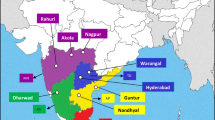Abstract
Bacterial blight caused by Xanthomonas campestris pv. punicae (Xcp) has emerged as a potential threat in pomegranate (Punica granatum) cultivation in India. Here, we report the genomic fingerprints and their correlation with virulence pattern of Xcp isolates from Maharashtra and Delhi. The genomic fingerprints of Xcp isolates were generated using enterobacterial repetitive intergenic consensus (ERIC) sequence-based primers, and virulence level was based on their reaction upon infiltration to susceptible pomegranate cultivar. Maharashtra isolate PGM1 showed only 50% similarity with Delhi isolate PGD8 forming a distinct genotype, whereas the Delhi isolates PGD5 and PGD6 form a cluster with Maharashtra isolates PGM2 and PGM4. The isolates PGM2, PGM4, PGD5, and PGD6 showing mean disease score of 7.47 were marked as group A or highly virulent. The moderately virulent or group B isolates PGM3 and PGD7 produced mean disease score of 4.19, whereas less virulent or group C isolates PGD8 and PGM1 gave mean disease intensity of 1.91. A correlation between genotypic groups based on ERIC fingerprints and pathogenicity of the isolates was established. The highly virulent isolates PGM2, PGM4, PGD5, and PGD6 formed a single cluster. A unique 900 bp amplicon present in all highly virulent isolates has been identified that can be used as genetic marker to screen isolates for virulence. The less virulent isolates PGD8 and PGM1 formed single cluster at 50% similarity coefficient. This seems to be the first report to establish a correlation between ERIC-PCR fingerprints and their corresponding virulence pattern of the pomegranate bacterial blight pathogen.


Similar content being viewed by others
References
Asubel FH, Brent R, Kingston RE, Moore DD, Seidman JG, Smith JA, Struth K (1994) Current protocols in molecular biology. Wiley, Canada, p 2.4.1
Chand R, Kishun R (1991) Studies on bacterial blight of pomegranate. Indian Phytopathol 44(3):370–372
Hingorani MK, Mehta PP (1952) Bacterial leaf spot of pomegranate. Indian Phytopathol 5:55–56
Louws FJ, Bell J, Medina-Mora CM, Smart CD, Opgenorth D, Ishimaru CA, Hausbeck MK, de Bruijn FJ, Fulbright DW (1998) Rep-PCR-mediated genomic fingerprinting: a rapid and effective method to identify Clavibacter michiganensis. Phytopathology 88:862–868
Louws FJ, Fulbright DW, Stephens CT, de Bruijn FJ (1994) Specific genomic fingerprints of phytopathogenic Xanthomonas and Pseudomonas pathovars and strains generated with repetitive sequences and PCR. Appl Environ Microbiol 60:2286–2295
Mondal KK, Singh D (2008) Bacterial blight of pomegranate—a technical bulletin. Division of Plant Pathology, Indian Agricultural Research Institute, New Delhi, p 8
Nei M, Li WH (1979) Mathematical model for studying genetic variation in terms of restriction endonucleases. Proc Natl Acad Sci U S A 76:5269–5273
Rohlf FJ (1997) NTSYS-PC 2.1. Numerical taxonomy and multivariate analysis system. Exeter Software, New York
Author information
Authors and Affiliations
Corresponding author
Rights and permissions
About this article
Cite this article
Mondal, K.K., Mani, C. ERIC-PCR-Generated Genomic Fingerprints and Their Relationship with Pathogenic Variability of Xanthomonas campestris pv. punicae, the Incitant of Bacterial Blight of Pomegranate. Curr Microbiol 59, 616–620 (2009). https://doi.org/10.1007/s00284-009-9482-z
Received:
Revised:
Accepted:
Published:
Issue Date:
DOI: https://doi.org/10.1007/s00284-009-9482-z




